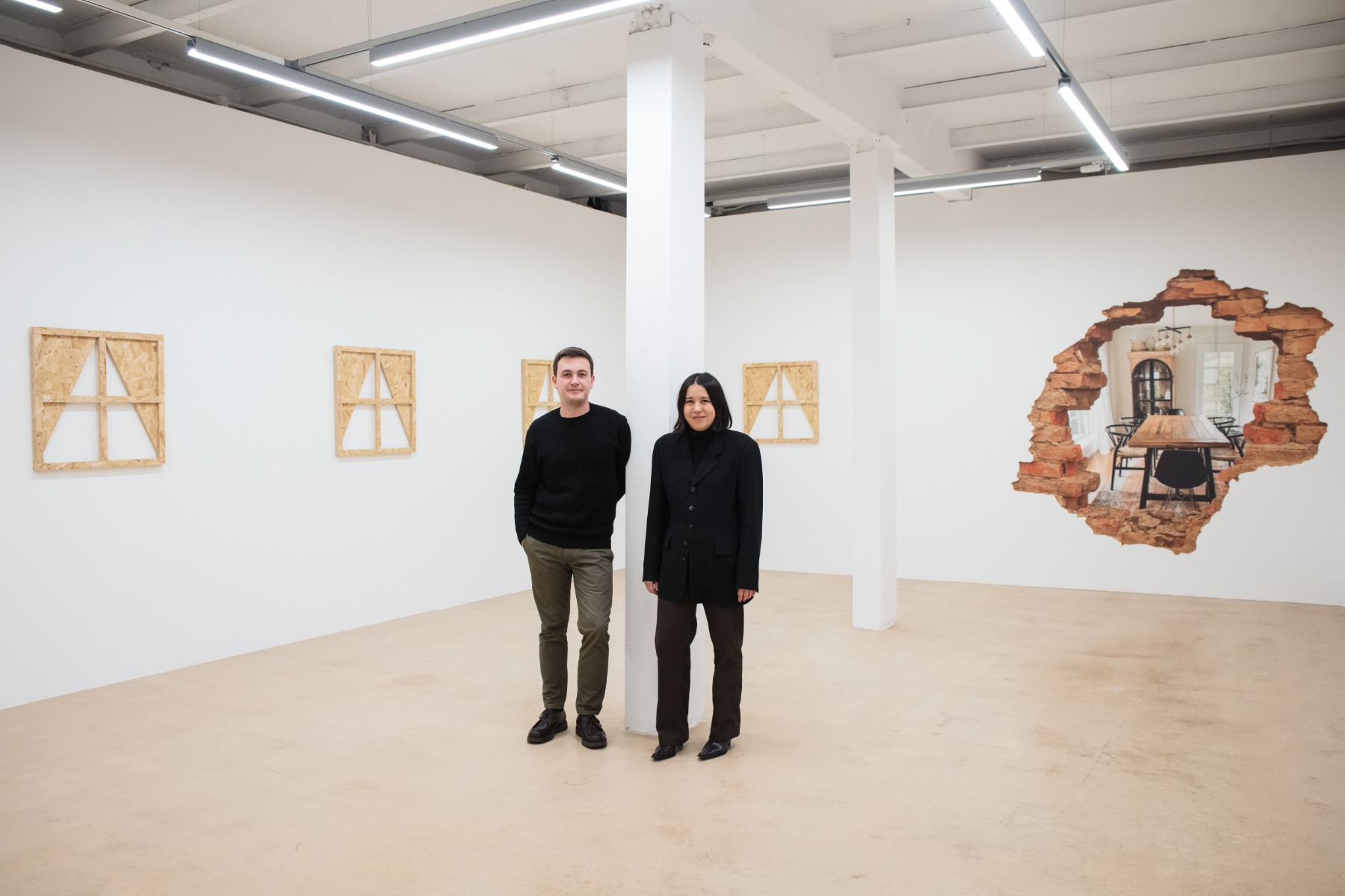
A Really Unusual Business
An interview with Jenny Borland and Mathew Sova of Jenny’s
Jenny’s, a gallery co-directed by Jenny Borland and Mathew Sova, was founded in 2014 in Los Angeles, but recently re-located to New York City. Jenny’s stands apart from many other commercial galleries – less calculated and more playful, their approach to running the space is founded on an intuitive dialogue between friends and artists of all stages in their careers.
Jenny and Mathew were in Riga for a few days to install the show Nothing To Write Home About currently up at Kim? CAC. At the center of the exhibition is the work of the late New York artist and poet Joe Brainard (1942–1994). Brainard’s miniature assemblages from the 70s are shown together with the work of three contemporary artists also interested in the uncanny of the everyday – Carter Seddon, Morag Keil, and Gina Fischli. We speak about the exhibition, Jenny’s recent move to NYC, and running an art gallery in this day and age.
You’re in Riga to install the exhibition Nothing to Write Home About. Can you talk a bit about it?
Jenny: We were invited by Zane [Onckule, Program Director at Kim?] four or five years ago at this point. It’s been a long time in the making. We always had in mind this group of artists, but the works have changed since our original proposal. There are three young artists and one historical artist in the show. The three younger artists are people we’ve worked with before at the gallery. Carter Seddon is a photographer; he is based in New York now, but he used to live in LA. We’ve worked with him for a long time. Morag Keil did these holes and the shoe clock in the front room. She lives in London and has had lots of shows in the last few years. Gina Fischli made the windows. We met her in London when she was studying at the Royal Academy and she’s now living in Zurich.
These are artists that we’ve been friends with for a long time. We wanted to put them in dialogue with an older, historical artist. We’ve done shows with later-career artists at the gallery before; we’ve always been interested in a dialogue between generations. Joe Brainard has probably never before been seen in Latvia. He was a poet and writer in the 1960s and 70s in New York. He also made a lot of art work – collages, paintings, drawings. He was involved in pop art and the New York School of poets during that time. We read his writing when we were younger and have always been very interested in his work, but hadn’t seen a lot of it.
We worked with Tibor de Nagy, an established gallery in New York that shows mostly historical artists [and represents the estate of Joe Brainard]. We loved these little miniatures. They’re like teeny tiny two-inch collage pieces. We told the gallery that we’re doing a show in Riga and they offered them to us on loan. The exhibition went through a long process of planning, postponing, and restructuring. The Brainard pieces were the only thing that has been consistent the whole time. We knew those were in the show, but everything else has kind of changed.
Mathew: The artists wanted to show new work.
Morag Keil. Clock, 2022. Clock mechanism, shoes. Dimensions variable. Exhibition 'Nothing To Write
Home About' organized by Jenny’s, New York at the Kim? Contemporary Art Centre, Riga. 2022. Photo: Kristīne Madjare
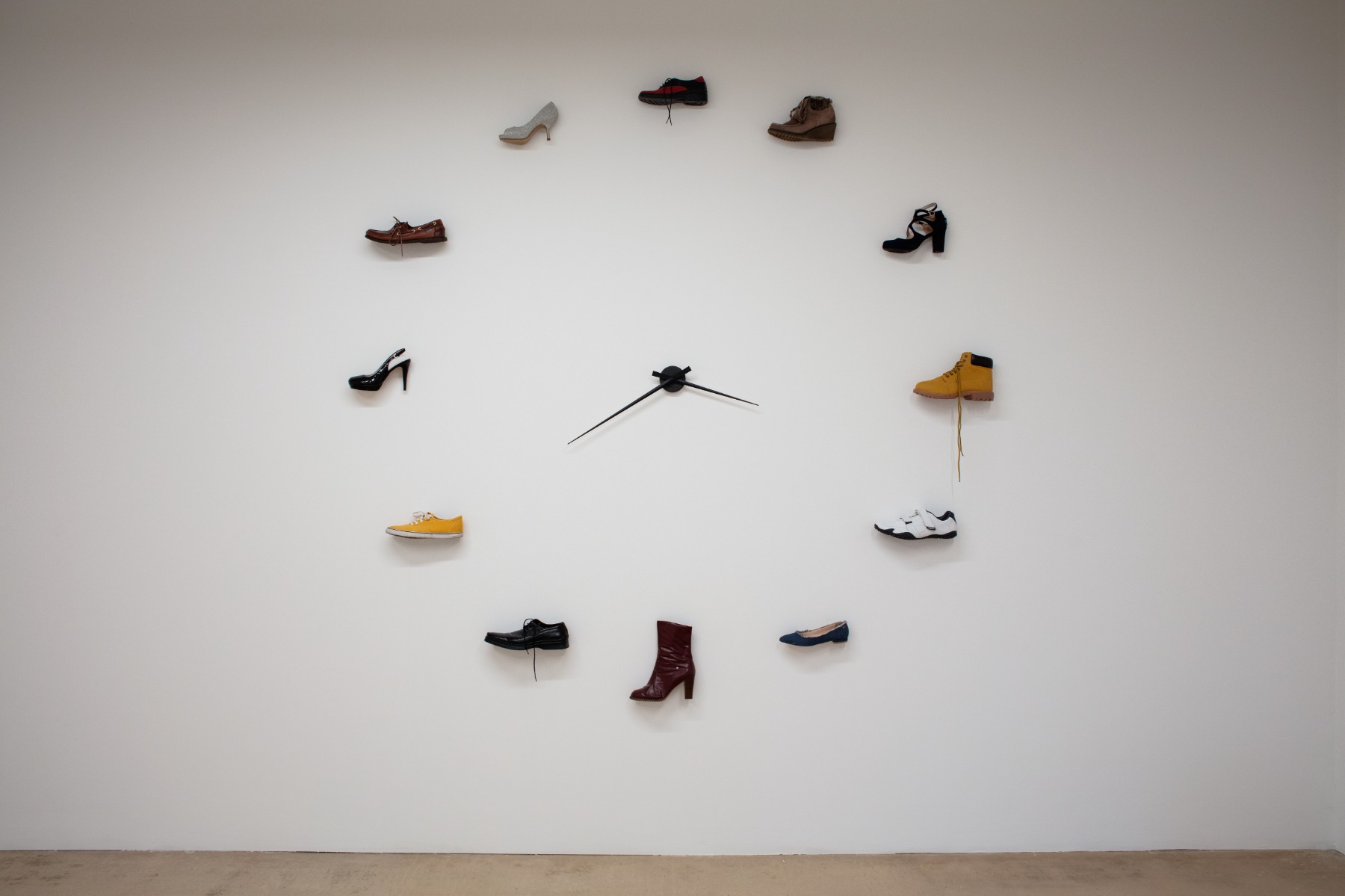
Did they make new work for the exhibition in dialogue with the Joe Brainard pieces?
Jenny: No, interestingly, none of the artists knew what the others were making. We don’t do a lot of group shows, mainly because our gallery space is so tiny, but the few times we’ve done them it’s been organized in this way. No one really knows what the other is doing, but somehow it works out fine.
Mathew: I think because a lot of the artists we work with have shared interests in certain things, like, the language of advertising, a relationship to pop art, or the picture generation; there is some thread that we intuitively find in the people we work with.
The [Joe Brainard] collages use the language of advertising and also depict domestic scenes or objects, which is something all of these artists do.
Jenny: Right, yes. We didn’t plan it this way originally, but it has almost turned into this house.
View from the exhibition 'Nothing To Write
Home About' organized by Jenny’s, New York at the Kim? Contemporary Art Centre, Riga. 2022. Photo: Kristīne Madjare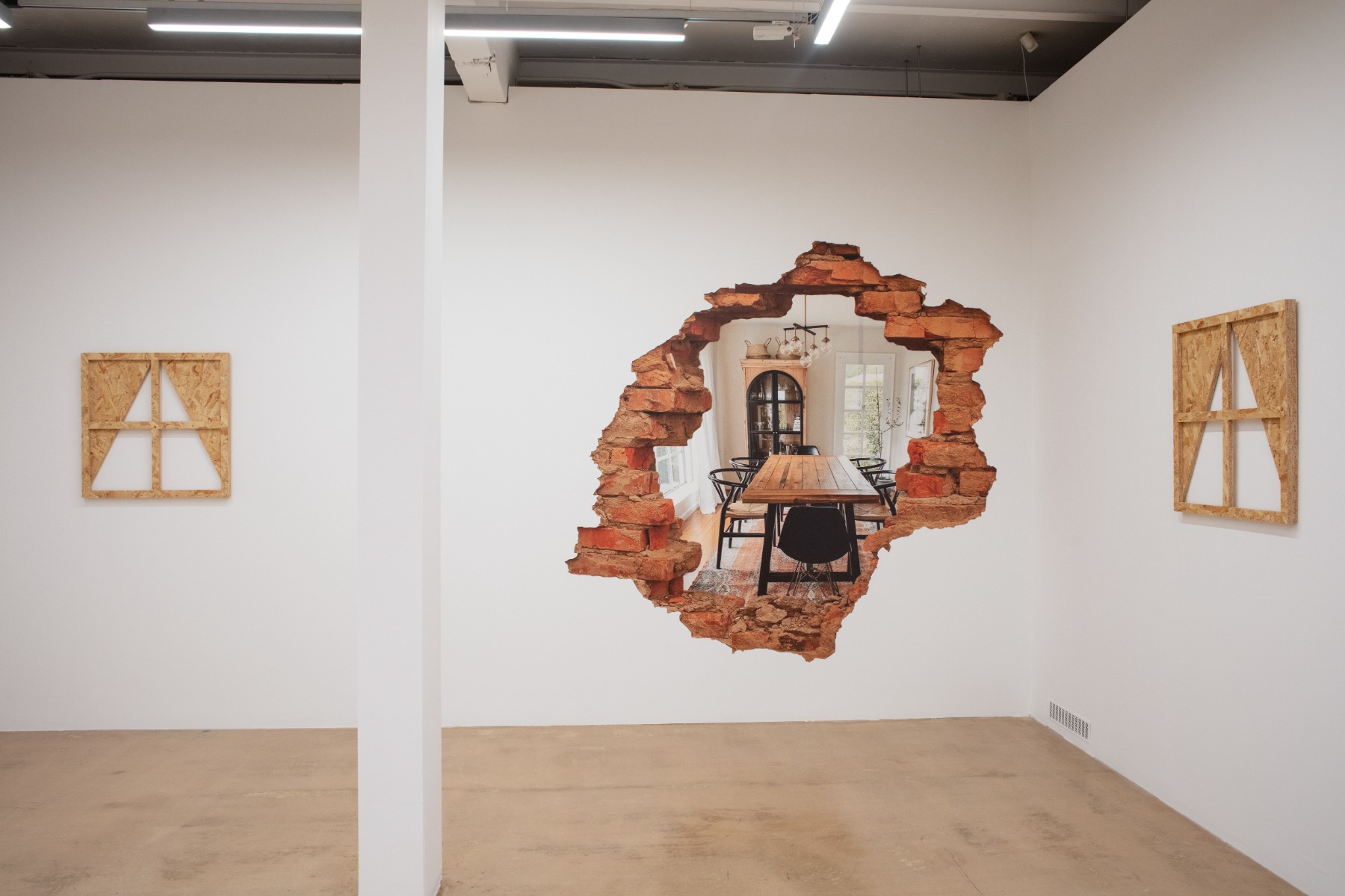
And the title is “Nothing To Write Home About.”
Jenny: Yes, the title comes from a Joe Brainard book he made in the 80s. It’s a series of short texts. We just really liked the name.
Mathew: It’s a phrase in English that means “nothing special”, that’s the gist of it.
Jenny: They had a hard time translating it as it’s one of those colloquial things you say.
Joe Brainard's miniature collages at the exhibition 'Nothing To Write
Home About' organized by Jenny’s, New York at the Kim? Contemporary Art Centre, Riga. 2022. Photo: Kristīne Madjare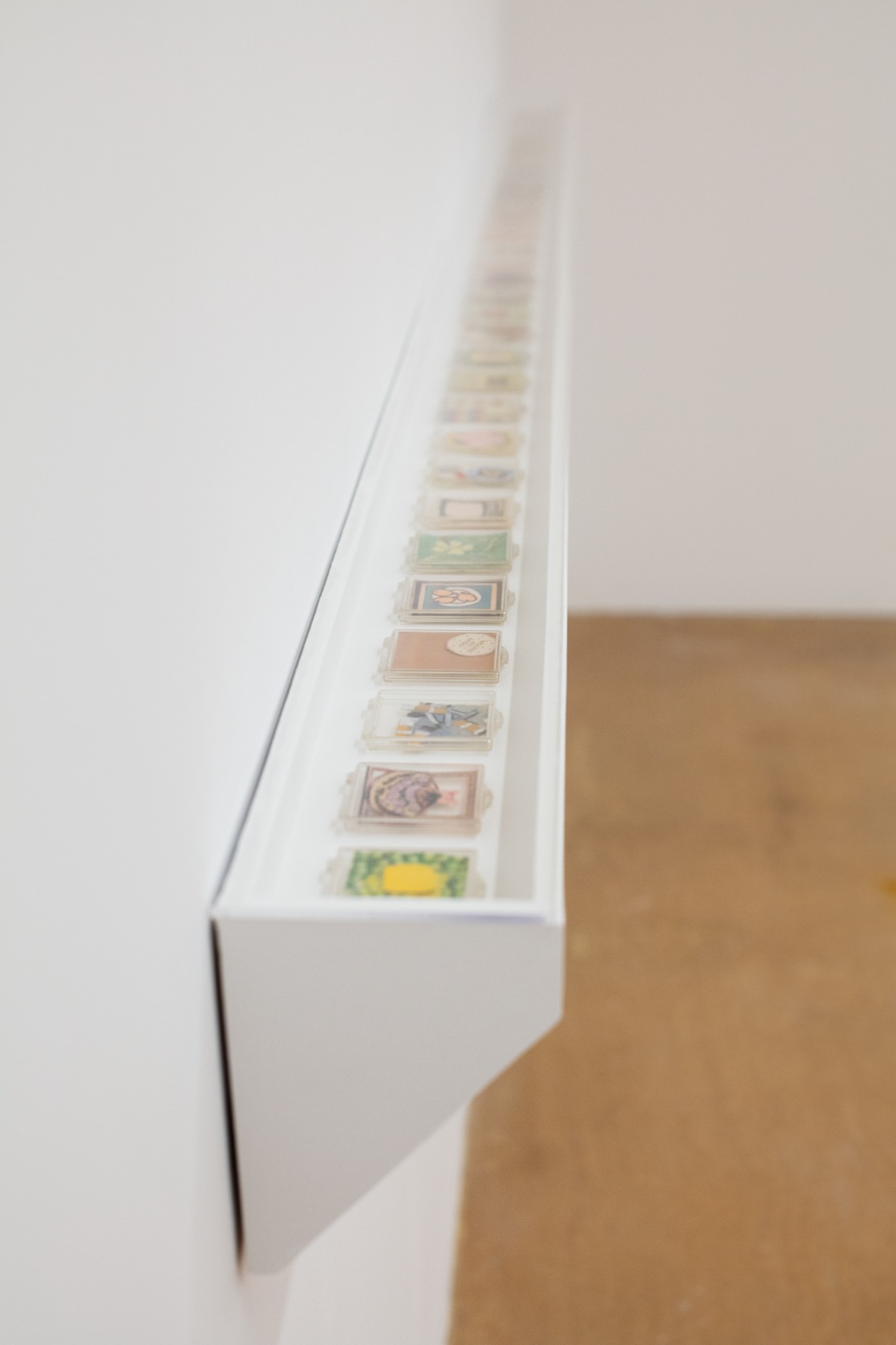
Joe Brainard. Untitled (Male Early In The Day), n.d., mixed media collage, 5 x 5 cm. Courtesy Estate of Joe Brainard and
Tibor de Nagy Gallery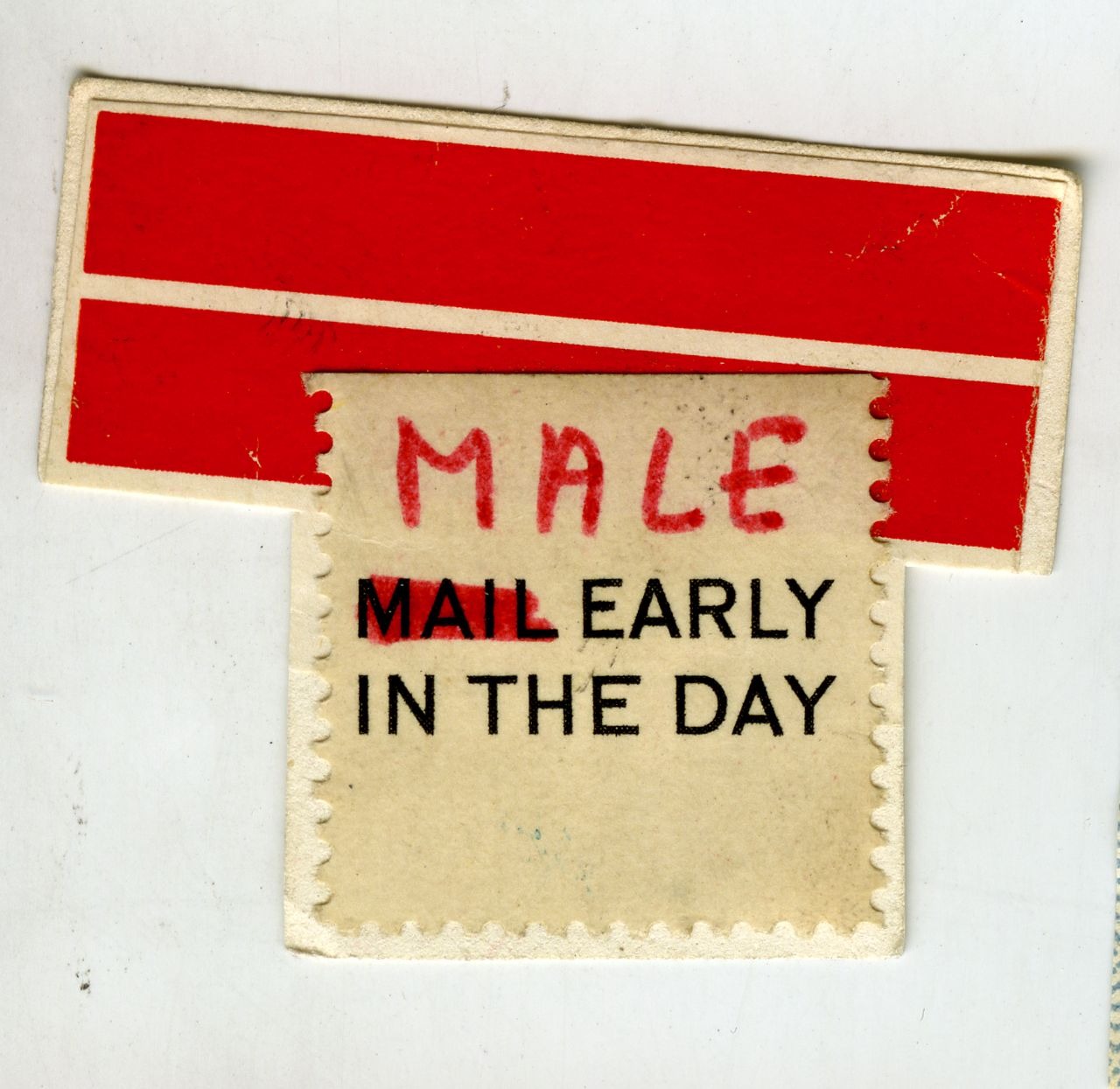
Joe Brainard. Untitled (Abstraction). n.d., ggouache on paper, 5 x 5 cm. Courtesy Estate of Joe Brainard and
Tibor de Nagy Gallery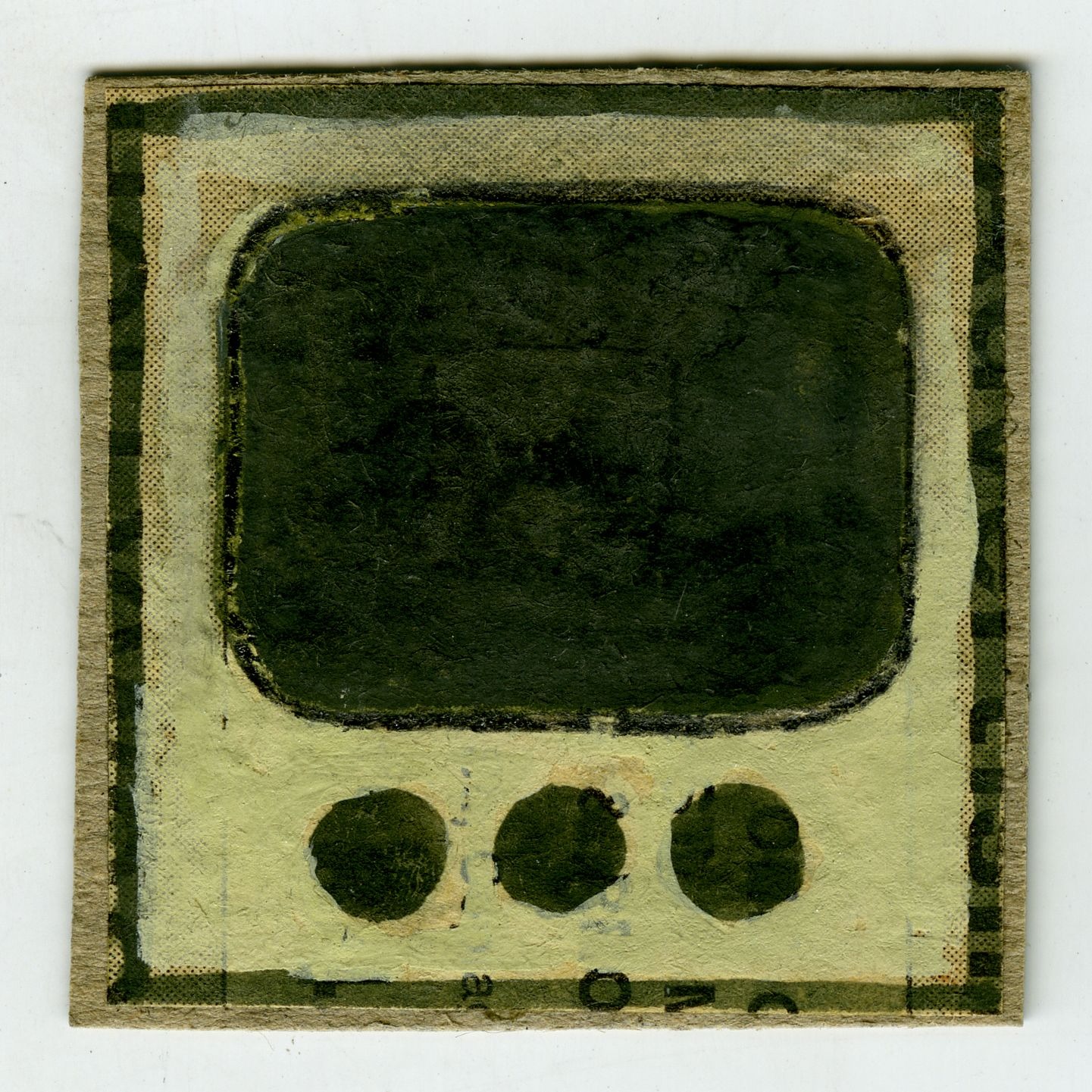
In the statement for the exhibition, you talk about the “daily strangeness of our surroundings.” That’s a feeling that runs through the entire show.
Mathew: Right. Carter is someone I went to school with, and I’ve always been drawn to his work. There’s something uncanny; the images look like something so familiar. It’s like something you’ve seen before, like a postcard – so obvious. He’s been taking photos in this way for so long. He sticks with it and that is something I really respect.
Jenny: We didn’t plan it this way, but all of these works were made during Covid. Gina was literally at home staring at her windows all day. And Morag also made these at home. Carter was taking photos of his neighborhood and his apartment. It has this homey, isolated feel just because that’s when the works were made, but that was not considered when we were planning the show. They all wanted to show new work, so it worked out that way. That’s why it has this domestic feel to it.
View from the exhibition 'Nothing To Write
Home About' organized by Jenny’s, New York at the Kim? Contemporary Art Centre, Riga. 2022. Photo: Kristīne Madjare
It’s interesting what you say about chance and that things just evolve on their own, but fit together in the end.
Jenny: Yeah, I think what Matt said is very true. The artists we choose to work with, they’re all our friends and there’s a shared sensibility between us. We didn’t have to go through the process of selecting works. We just left it up to them. We were sure that what they will make will be great.
There are practical considerations too, like, shipping things. But we’ve done a lot of art fairs in Europe so that was a good preparation for this – being ready to install right away. Kim? has been amazing, very helpful, so it’s been a very good experience. And it’s super unusual for this to happen. Commercial galleries in the US never get asked to organize a show in an institution. These worlds don’t collide, but Kim? is so interesting because of that. They’re trying to figure out this in-between space – a commercial project, something that doesn’t really exist in Latvia, and then a non-profit. It’s really interesting. We run the gallery more like a project space, though we are a commercial gallery.
Gili Tal. Roaming. July 23 - September 3, 2016 / Jenny’s, Los Angeles / Photo: Jeff McLane / Courtesy: the artist and Jenny’s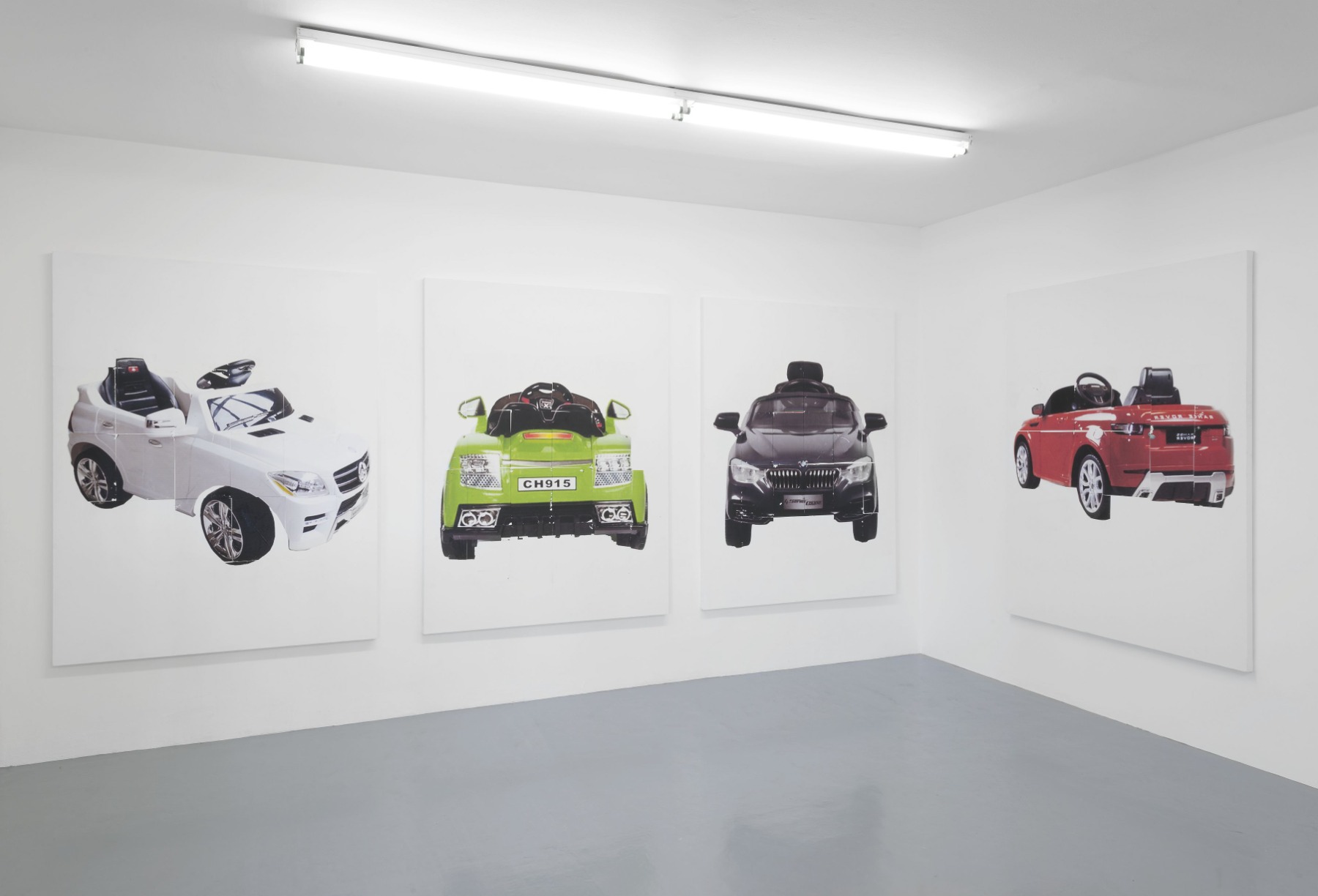
I wanted to ask about the history of Jenny’s – how did you decide to open a gallery in the Silver Lake neighborhood of Los Angeles in 2014?
Mathew: It’s a funny story. It wasn’t really planned out. I was living in LA after having left New York. Jenny was still in New York. A friend of ours, the artist Mathieu Malouf, was in LA in a self-imposed residency, wanting to be there for a couple of months to make paintings. I happened to cross this place or, basically, just a phone number for an empty space. At the time it was very low-commitment with the landlord, so Mathieu and I decided to take the space to do a show of him, but not necessarily anything beyond that. Then the reception was so enthusiastic…
Jenny: I remember you and Mathieu called me. I was working at Artists Space in New York at the time and I was done with the job. They called me and said that they had found this space in LA. I’m from there so I thought I could just go for a month and see what happens. We did the show and it was like Matt said – people were so excited. LA is a big deal now, but back then there was very little in the way of small spaces happening.
We decided to call it “Jenny’s” as a joke. We were thinking it was just going to be temporary, we’ll have it open for a month or something. Mathieu encouraged us to use our names.
Mathew: Something casual.
Jenny: There was already a gallery called “Mathew” in Berlin. It’s also not “Jenny’s Gallery”, but “Jenny’s”. We were thinking that if the gallery fails, it could just become a cafe or a bar. But it just grew in this organic way. We just had fun with it. It’s become more work, but it’s still fun. I don’t think we’d do it if we didn’t enjoy it. That’s the origin story.
Like you said, LA is such a big deal now. There are many new spaces, big commercial galleries are branching out, there’s now a Frieze LA… But last year you decided to move to New York.
Mathew: Covid allowed us to make a big change. I think we were overextending ourselves by going to art fairs multiple times a year in order to see our clients, who are either in New York or in Europe. We weren’t able to cultivate a collector base in LA in the same way as we could somewhere else. We had been thinking about moving the gallery prior to that, but couldn’t figure out the logistics and then, when there was this pause, it allowed us to. It was a bit slow to start in New York, but now it’s getting a lot of momentum.
Jenny: And interestingly, the space in New York was the studio of the same artist who found our space in LA. He was moving out of his studio into a bigger space. And before it was Mathieu’s studio, this space in New York had actually been the studio of another artist we work with, so we had seen it before. It’s small, the same size of the LA space.
Again, Matt was there first, and I was in LA. It sounds ridiculous, but it’s true. The lease was up for our gallery space, and the landlord was asking us whether we still wanted it. I felt like we had done so much there and so much for LA; we thought that chapter was closed. Since both of us had lived in New York before, it wasn’t like going somewhere completely new and a lot of our artists and friends are there. The pandemic allowed it to be possible. We could have never done that otherwise; money- or time-wise, it wouldn’t have worked. It was unexpected, but I’m really happy we moved. We’ll see what happens next.
You already talked a bit about this, but how do you decide what artists you want to work with? It feels very grassroots – many of the artists who you show are your friends, but do you also meet people from outside your world?
Jenny: We don’t really go around on a bunch of studio visits to pick and choose people. We’ve done that, but it’s not really the way it works. It is very grassroots and just happens kind of naturally. There are a lot of artists we would like to work with. We travel a lot, so we’ve been very lucky to be able to go around the world and have met tons of people and friends of friends.
In LA it was actually amazing that there were so many older artists that hadn’t had shows in a long time. We did a show with Larry Johnson. That was huge for us. This is someone whose work we both have loved forever. Him wanting to do a show with us felt crazy. Being in LA for that reason was really great. New York is harder because everyone already has a gallery and has done stuff there. But it’s been really nice to be there over the last year because we’ve pretty much only done shows with New York artists. Partially for practical reasons because people haven’t been able to travel, but it’s been good. We’ve met and shown new artists this year from meeting them in New York.
What would you say are the biggest challenges of running a small gallery?
Jenny: There’s a lot.
Mathew: I mean… Money. Everything the gallery makes goes back into being able to do future shows. There is no consistent source of money, so that can be challenging.
Jenny: And it’s just us. We don’t have someone working for us. We have a gallery sitter for when we’re gone, but we don’t have any employees. We’ve had interns. It would be nice if we could have more help, but the way that the gallery operates is very much also about the way that we interact with and understand each other. We’ve both worked in galleries a lot. It’s tough. It’s a really unusual business. I have a job on the side and Matt also does other work. We work a lot because you have to just keep things in motion. Especially in New York because it’s so expensive. But there are so many rewards that come out of it that it’s worth all of the stress and hard work.
Julien Ceccaldi. Centuries Old. September 10 - October 23, 2021 / A two venue exhibition at Jenny’s and Lomex, New York / Photo: Carter Seddon / Courtesy: the artist and Jenny’s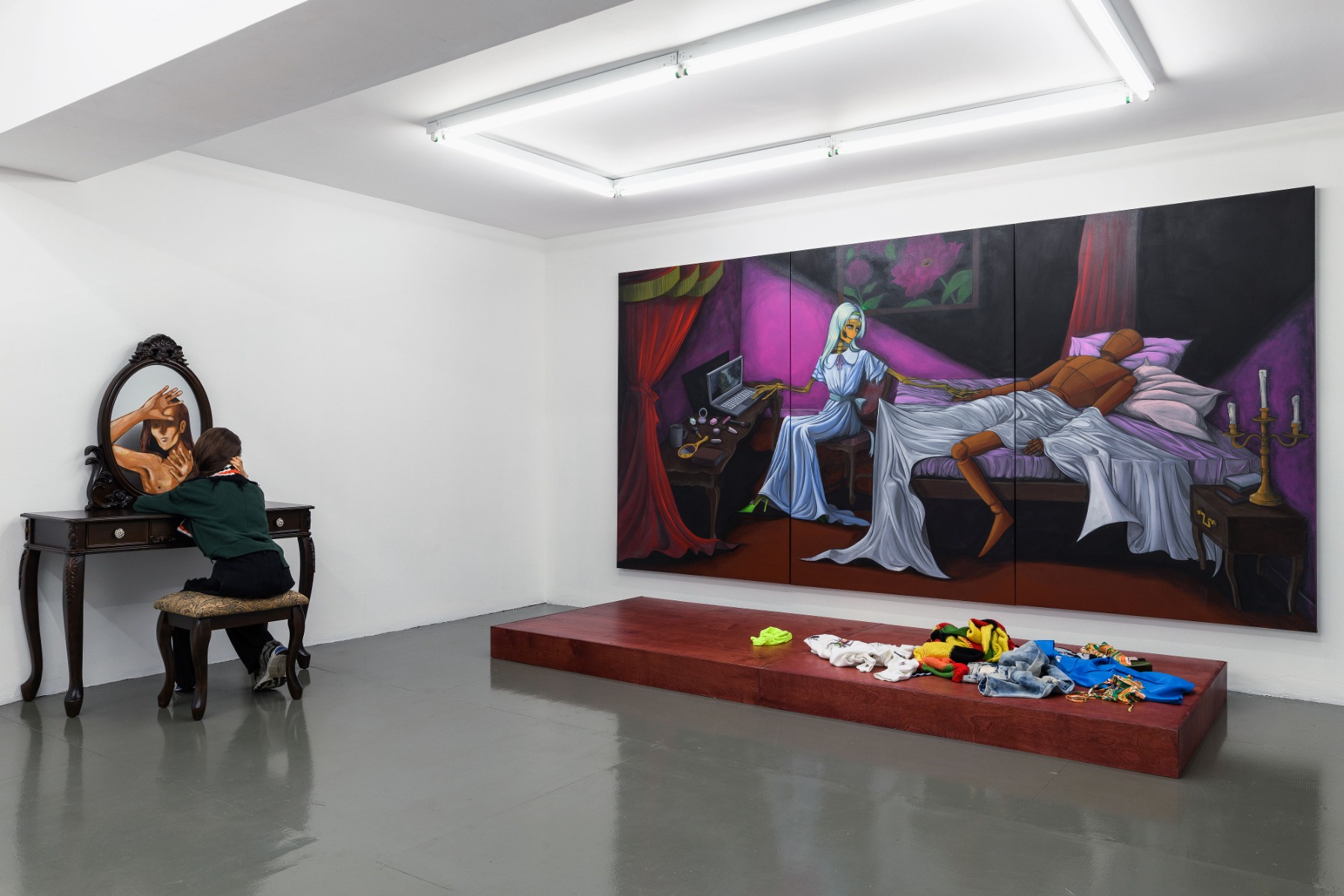
Going through your website, I noticed you did a lot of painting shows last year. There’s a lot of exciting painting now – people like Julien Ceccaldi, one of the artists you work with, uses this really traditional art form to explore a contemporary vocabulary and aesthetic. I feel like there’s this, but then there are also other things of the moment, like NFTs. This show is also about a younger generation in dialogue with a historical artist. How do you feel about these more traditional art forms while certain parts of the art world are trying to change and transform?
Mathew: Morag is an interesting case because her work is often a nexus of technology and more traditional forms of making things. She works in many different media. She makes a lot of video and sculpture, but she also makes paintings. Gina too. It’s mostly sculptural, but it’s always with the idea of painting. Carter is pretty much a photographer.
Jenny: And, yes, Julien is a really good example. His language is developed from animation and comics. He’s such a scholar of that. He’s been dabbling with more digital things lately; he’s done some digital drawings to try and make video animation. His work reads so well. I think it’s also about how things read on the internet. I feel like people make artworks to be shown in photographs because that’s how they’re seen. Everything is digitized. Nobody in New York will see this show, so even while we’ve been installing, we’ve been thinking about photography and how things will read from afar.
Mathew: We didn’t dictate what kind of shows we wanted. Several of those artists aren’t necessarily painters, but they felt compelled to make paintings. Maybe in this climate, it seems like a safer choice or something? There’s been a lot of painting in New York.
Jenny: It’s back.
Mathew: It’s everywhere.
Julien Ceccaldi. Centuries Old. September 10 - October 23, 2021 / A two venue exhibition at Jenny’s and Lomex, New York / Photo: Carter Seddon / Courtesy: the artist and Jenny’s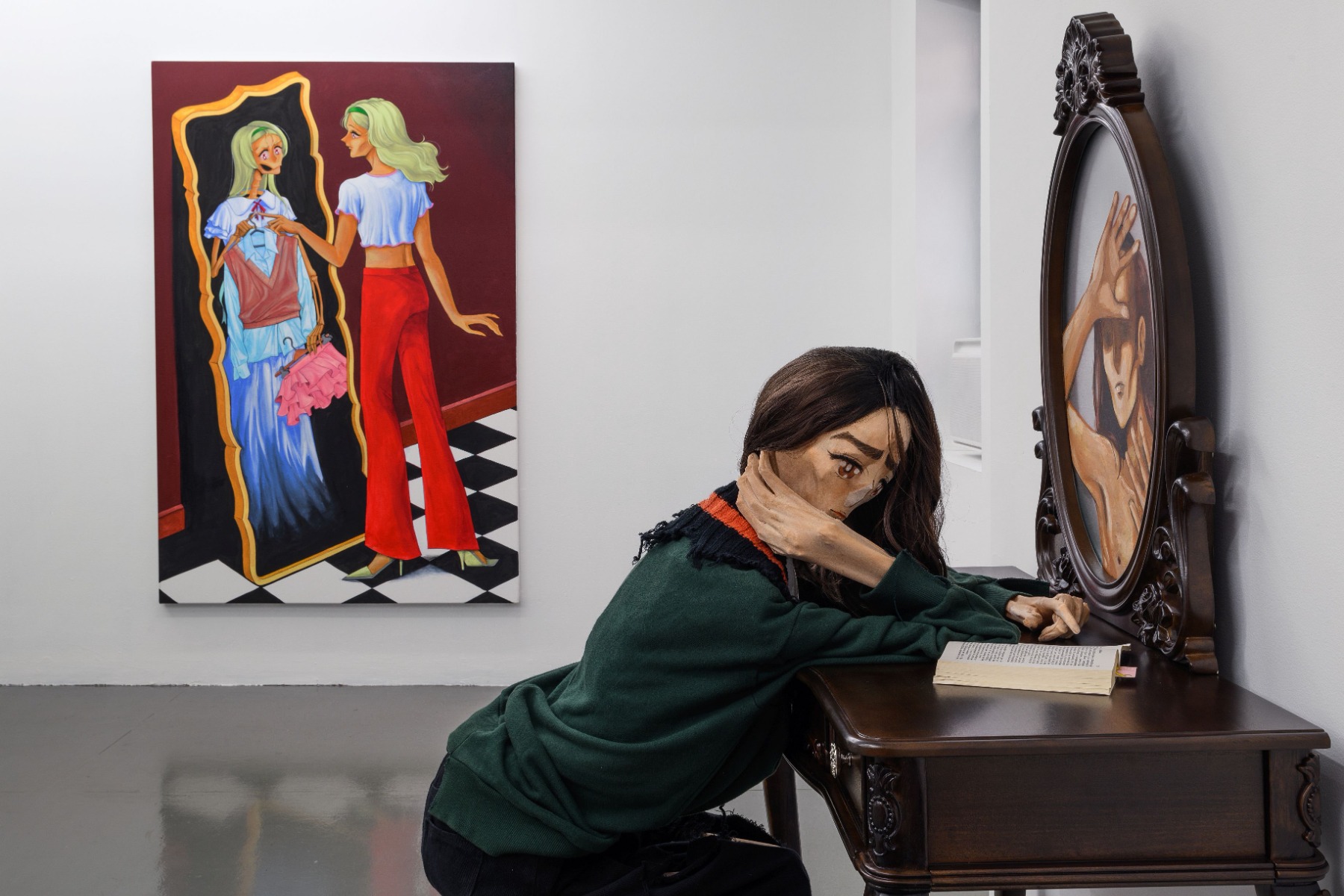
Jenny: I think historically most of the shows we’ve done haven’t been painting shows. You picked up on that because it’s true – LA was all over the place. A lot of installation and sculpture. Our next exhibition in New York is a video show, a film. I think a lot of galleries do follow the trend and they’re like, ok, we have to do this kind of show, but we do whatever the artist wants to do.
Mathew: I don’t know if anyone we know has been considering doing NFTs or anything like that. I’m not sure why.
Jenny: Because it’s confusing. What is it?
It is confusing, but so many people are talking about it.
Jenny: It has cultural currency.
One last question. What’s the most exciting art-related thing you’ve seen or experienced recently (besides this exhibition)?
Jenny: Good question. This would be most exciting for me because we were able to get out of the US for a minute.
Mathew: We’ve been in New York primarily, so it would have to be something there. There was an amazing Cézanne drawing show at MoMA that was probably the best thing I’ve seen since I’ve been back to New York.
Jenny: There have been some good shows. We’ve been to some fun art events. Our friend’s gallery, Lomex in New York, did this really cool H.R. Giger show. That’s pretty exciting. He was working on it forever, so this is like a dream show. It’s pretty amazing to see these works in person. You see a lot of reproductions, but to see them actually in the flesh is really cool and a rare opportunity. It’s exciting to me to have a friend, a peer’s gallery, do something that is such a big deal for them. It’s exciting to see because we have a lot of friends who run galleries too and everyone is pretty supportive of each other. It’s tough and you’re all in it. We were really pleased by our reception in New York – that people were happy that we came. It wasn’t a super competitive thing. It’s been a warm welcome. That’s mine.
Mathew Sova and Jenny Borland. Photo: Kristīne Madjare